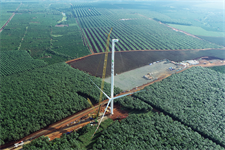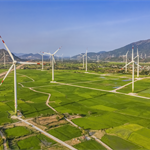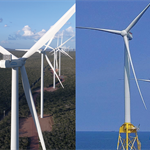Analysis: Biden’s offshore wind targets in peril but will regulators or developers blink first?
Energy Disrupter

President Biden’s administration has set a target of 30GW of offshore wind capacity installed by 2030.
But Ørsted’s decision to pull out of Ocean Winds 1 and 2, off the coast of New Jersey, accounts for approximately 2.2GW of that goal and constitutes a significant blow.
Ørsted’s announcement follows a slew of other project cancellations, including by BP and Equinor, which have also decided to swallow multi-million dollar impairment hits rather than proceed with projects which they say are now unviable.
Still on track?
Some analysts now argue that Biden’s 30GW target is in serious jeopardy. BloombergNEF, for example, suggests that just 16.4GW of US offshore wind will be operational by 2030.
But in the wake Ørsted’s announcement, both the White House and the US Department of the Interior issued statements expressing faith that the 30GW target can still be realised on time.
“Momentum remains on the side of an expanding US offshore wind industry,” insisted White House spokesman Michael Kikukawa.
Meanwhile, Elizabeth Klein, director of the Bureau of Ocean Energy Management (BOEM) said the federal government remains “committed to supporting the build out of this new industry in a way that will benefit communities, strengthen our nation’s energy security and address the climate challenge”.
‘Future is strong’
US industry group, the Oceantic Network – formerly the Business Network for Offshore wind – said it was “extremely disappointed” by Ørsted’s decision and that it served as a reminder of the “hard work” needed to build a supporting supply chain.
Sam Salustro, vice president of strategic communication for the network, put a brave face on the setback, adding: “Make no mistake – offshore wind’s future in the US is strong”.
By example, Salustro pointed to federal environmental approval for Dominion Energy’s 2.6GW Coastal Virginia Offshore Wind project, which was granted approval only the day before Ørsted’s announcement.
Other positive signs, he said, included Ørsted’s final investment decision to begin construction of the 704MW Revolution Wind project in New England, as well contracts for 4GW awarded in New York state with another accelerated tender round in the works.
Salustro affirmed that New Jersey will remain a market leader and “continue emerging as a hub of manufacturing, logistics and development for the industry.”
New Jersey’s fury
But there is no doubting the level of anger within New Jersey’s state government directed at Ørsted’s bombshell decision.
Having secured additional state support for Ørsted earlier this year for its Ocean Wind 1 project, state policymakers were clearly furious that the developer was scrapping both projects.
Governor Phil Murphy accused Ørsted of abandoning its commitments to the state and he slammed the decision as “outrageous”, adding that it “calls into question the company’s credibility and competence”.
Murphy has referred the matter to the state’s legal team and said it will review all legal remedies, as well as “take all necessary steps to ensure that Ørsted fully and immediately honors its obligations”.
Ørsted’s shares plummetted after it announced the cancellation of Ocean Wind 1 and 2, along with a DKK28.4 bn (€3.8bn) impairment hit; significantly more than the DKK16 bn it had forecast in August.
But Mads Nipper, CEO of Ørsted, was unrepentant during an earnings call following its third quarter results. He said it was the right business decision and that it gave investors greater clarity going forward.
‘Market headwinds’
Even Murphy, in his anger, conceded that the project had fallen victim to wider market headwinds, including inflation, faced elsewhere. “As we have seen in other states recently, offshore wind projects awarded prior to 2020 have been impacted by a combination of interest rate escalation, supply chain cost increases and inflation. And while today is a setback, the future of offshore wind in New Jersey remains strong,” he said.
Murphy pointed to the high number of bids in New Jersey’s third offshore wind solicitation and said the state’s Board of Public Utilities would announce two additional solicitations related to its strategy to build an offshore wind transmission infrastructure.
“I remain committed to ensuring that New Jersey becomes a global leader in offshore wind – which is critical to our economic, environmental and clean energy future,” Murphy said.
Regulators pivot
While state regulators have been largely reluctant to green-light contract renegotiations for older projects approved before the cost crisis – which typically had either fixed nominal prices or a fixed annual escalator – they have adapted the process for others.
Inflation indexing has been widely introduced for recent and upcoming tenders in the US. Rhode Island and Connecticut now have mechanisms to protect developers against cost increases that are beyond their control built in.
Nipper welcomed the development of regulators in the US and other regional markets beginning to reflect the macro-economic landscape in tenders and he told investors it was the market “reset” that was needed, reflecting the real cost of offshore wind today.
“I’m happy to see that most US states are acting [on] that now, and that in core markets in Europe such as the UK or Poland, the offtake contracts with countries or states [are] inflation-indexed,” he said.
“There’s inflation protection and that means both inflation and supply chain [difficulties are] properly mitigated, but also there is typically a correlation between interest rates and inflation. That…gives an additional cushion and safety for investors when there’s inflation indexing.”
Nipper noted that winning prices secured in New York’s latest tender were some 40-50% higher than some of the earlier projects which had not been abandoned, for example.
Finding the ‘new normal’
It is a welcome change because developers and regulators have, until now, been in high-stakes game of ‘chicken’ waiting to see which will blink first; with the former threatening to walk away from projects and the latter refusing to give ground.
“It has to begin with the regulator’s becoming cognizant of increased cost and accepting higher bid prices,” explained Shashi Barla, head of renewables research for Brinckmann Group in Windpower Monthly’s recent News Review podcast. “The best way to proceed forward is indexation linked to inflation.”
Even then, Barla added, “there are different pieces in this whole puzzle that need to be aligned” before a new normal for the market is achieved.
















